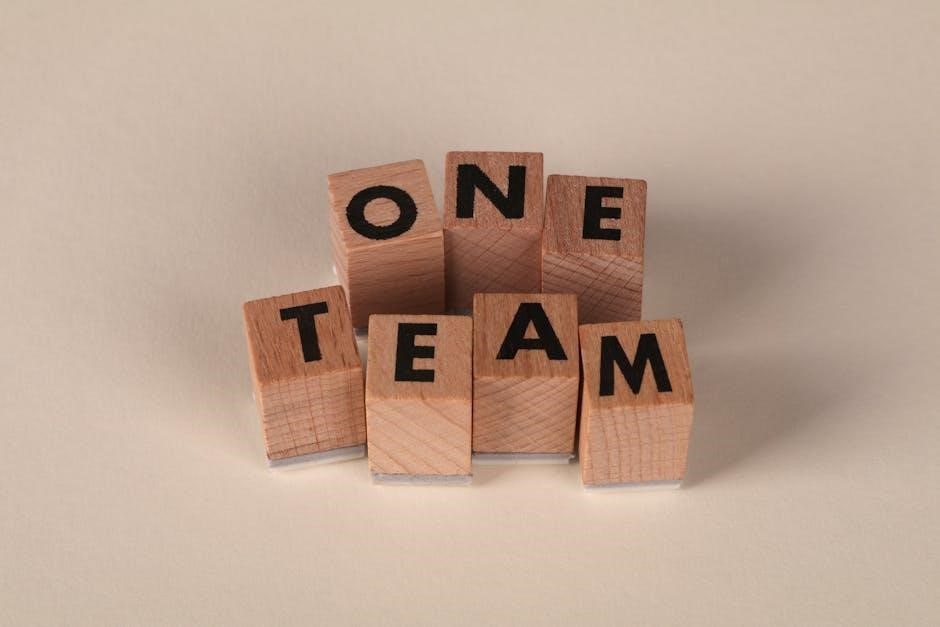
John Maxwell’s 5 Levels of Leadership provides a framework for leadership growth, from basic positional authority to achieving lasting legacy impact. Each level builds on the previous, helping leaders maximize their influence and effectiveness.
Overview of John Maxwell’s Leadership Model
John Maxwell’s 5 Levels of Leadership is a hierarchical framework that outlines leadership growth from basic authority to exceptional influence. It emphasizes progression through five stages: Position, Permission, Production, People Development, and Pinnacle. Each level represents a mindset shift, moving from reliance on title to earning trust, delivering results, empowering others, and ultimately creating a lasting legacy. Maxwell’s model highlights that leadership is not solely about position but about influence, relationships, and personal growth, offering a holistic approach to developing effective leaders.
Importance of Understanding Leadership Levels
Understanding the 5 Levels of Leadership is crucial for personal and organizational growth. It helps leaders identify their current stage, set goals, and develop strategies to progress. Recognizing these levels fosters self-awareness, enabling leaders to build stronger relationships, drive results, and empower teams. By mastering each level, leaders can enhance their influence, achieve organizational success, and create a lasting impact. This model serves as a roadmap for leadership development, ensuring continuous improvement and effective leadership in any context.

Level 1: Position
Level 1 is the foundational stage where leadership is based on title or authority. People follow because they have to, not because they want to.
Definition and Characteristics
Level 1: Position is the most basic stage of leadership, where authority is granted through a title or role. Leaders at this stage rely on their position to influence others, as people follow out of obligation rather than inspiration. This level requires no special skills or effort, as it is based solely on the rights associated with the position. However, it is the least effective level for fostering engagement or driving long-term success, as it lacks the personal connection and vision needed to motivate teams beyond basic compliance.
Challenges and Limitations of Position-Based Leadership
Position-based leadership often leads to disengagement, as people follow reluctantly, focusing only on obligations. This level lacks the personal connection and trust needed to inspire teams, resulting in limited creativity and initiative. Leaders relying solely on their title struggle to motivate beyond basic compliance, as they fail to provide a compelling vision or purpose. Without building relationships or earning respect, positional leaders face difficulty in sustaining long-term performance or loyalty, highlighting the need to progress beyond this foundational level to achieve greater influence and organizational success.

Level 2: Permission
Leaders at this level earn permission to lead by building relationships and trust, moving beyond authority to influence through mutual respect and shared goals.
Building Relationships and Trust
Trust is the cornerstone of Level 2 leadership, where leaders earn the right to influence others by building genuine relationships. This level focuses on connecting with team members, understanding their needs, and fostering mutual respect. By actively listening, showing empathy, and demonstrating reliability, leaders create an environment of openness and collaboration. Trust becomes the glue that strengthens these relationships, enabling leaders to transition from authority-based leadership to influence-based leadership. This shift from “having to follow” to “wanting to follow” marks the essence of Level 2, laying the foundation for deeper connection and shared goals.
Transitioning from Position to Permission
Moving from Level 1 to Level 2 requires leaders to shift from relying solely on their title to earning the right to lead through relationships and trust. This transition involves understanding that true influence comes not from authority but from connecting with people. Leaders must focus on building rapport, listening actively, and demonstrating genuine care for their team. By doing so, they create an environment where people choose to follow because they want to, not just because they have to. This transition is crucial for unlocking higher levels of leadership effectiveness and fostering a culture of mutual respect and collaboration.

Level 3: Production
Leaders at this level earn respect through consistent results and aligning their work with the organization’s vision, proving their value beyond their position or relationships.
Leadership Through Results and Vision
At Level 3, leaders demonstrate their value by delivering results and aligning their efforts with the organization’s vision. This stage is about achieving tangible outcomes, which builds credibility and trust. By focusing on shared goals, leaders inspire their teams to work towards a common purpose. Effective production leaders not only meet expectations but also contribute to the organization’s success, establishing themselves as indispensable. This level transitions leaders from reliance on position or permission to earning respect through their accomplishments and vision.
Impact of Production on Organizational Success
Level 3 leadership, focused on production, significantly impacts organizational success by driving results and aligning efforts with the company’s vision. Leaders at this stage build credibility by consistently delivering outcomes, fostering trust and confidence among stakeholders. Their ability to execute and achieve goals creates momentum, propelling the organization forward. By prioritizing measurable results, production leaders ensure their contributions directly support the organization’s objectives, solidifying their role as key drivers of growth and success. This level establishes a foundation for sustained effectiveness and long-term impact.

Level 4: People Development
Level 4 focuses on empowering and growing team members, creating a culture of development and empowerment. Leaders at this stage prioritize investing in their people, fostering growth and potential, which strengthens the organization and ensures long-term success.
Focus on Team Growth and Empowerment
At Level 4, leaders prioritize the growth and empowerment of their team members. This involves identifying individual strengths, delegating responsibilities, and creating opportunities for learning and development. By fostering a culture of empowerment, leaders enable their teams to take ownership of their work, leading to increased confidence and productivity. This level is about investing in people, helping them reach their potential, and building a legacy of strong, capable leaders. The focus shifts from personal achievement to the collective success of the team, ensuring long-term organizational growth and a positive work environment.
Strategies for Effective People Development
Effective people development at Level 4 involves intentional strategies like mentoring, coaching, and providing constructive feedback. Leaders create tailored development plans, aligning individual strengths with organizational goals. Encouraging continuous learning through training and resources fosters growth. Empowering team members through delegation and decision-making builds confidence and accountability. Recognizing achievements and celebrating progress motivates individuals to strive for excellence. These strategies not only enhance individual capabilities but also strengthen team cohesion, driving overall organizational success and sustainability. The focus is on equipping others to lead effectively, ensuring a legacy of capable and empowered leaders.

Level 5: Pinnacle
Level 5 leaders create lasting legacies by embracing opportunities others overlook, transforming industries, and inspiring others through their vision and selfless dedication to the greater good.
Legacy and Long-Term Impact
Level 5 leaders leave a lasting legacy by inspiring others and creating opportunities that transform industries. Their vision and selfless dedication to the greater good ensure enduring impact. They build organizations that outlast them, fostering a culture of excellence and empowerment. By combining humility with unwavering resolve, they set a standard that elevates their team, organization, and entire industry. Their influence extends beyond immediate achievements, shaping the future and leaving behind a timeless mark of leadership excellence.
Qualities of a Level 5 Leader

Level 5 leaders exemplify a rare combination of personal humility and professional will. They are driven by a vision beyond personal gain, prioritizing organizational success and team empowerment. These leaders foster trust, inspire loyalty, and create opportunities for others to thrive. Their ability to balance ambition with modesty sets them apart, making them exceptional mentors and legacy builders. By focusing on long-term impact, they cultivate a culture of sustained growth and excellence, leaving behind a lasting legacy that transcends their tenure.

Progression Through the Levels
Progression through the levels moves leaders from positional authority to higher levels of influence, focusing on production, people development, and ultimately achieving legacy impact.
Why Climbing the Leadership Levels Matters
Climbing the leadership levels matters because it enhances influence, fosters trust, and drives organizational success. Each level builds on the previous, developing leaders who inspire and empower others. Moving beyond positional authority, leaders gain the ability to produce results, nurture teams, and create lasting legacies. This progression not only benefits individuals but also elevates the entire organization, ensuring sustained growth and impact. Investing in leadership growth at each level is essential for maximizing potential and achieving long-term success.

Practical Application of the 5 Levels
Applying Maxwell’s 5 Levels involves self-assessment, relationship-building, and focused development. Leaders can progress by understanding their current level and actively working to enhance their influence and impact.

Assessing Your Current Leadership Level
Evaluating your leadership level involves reflecting on your influence and effectiveness. Identify where you stand among the five levels by examining your relationships, achievements, and team development. Consider how others perceive your leadership and the results you’ve driven. This self-assessment helps clarify strengths and areas for growth, guiding your journey toward higher levels of leadership impact and legacy.
Creating a Personal Development Plan
A personal development plan is essential for advancing through the 5 Levels of Leadership. Start by identifying your current level and set specific goals for progressing to the next. Focus on building relationships, delivering results, and empowering others. Seek feedback, engage in continuous learning, and practice leadership daily. Regularly review and adjust your plan to ensure alignment with your vision and aspirations. This structured approach will help you maximize your potential and achieve long-term success as a leader.
John Maxwell’s 5 Levels of Leadership guide leaders from positional authority to legacy impact. Each level builds on the previous, emphasizing growth, influence, and lasting organizational success.
Recap of Key Concepts
John Maxwell’s 5 Levels of Leadership offer a clear progression for leaders to grow from positional authority to legacy impact; Level 1 (Position) relies on title, while Level 2 (Permission) focuses on relationships. Level 3 (Production) emphasizes results, and Level 4 (People Development) prioritizes team growth. Finally, Level 5 (Pinnacle) achieves lasting influence and legacy. Each level builds on the previous, requiring leaders to invest in trust, results, and people to maximize their impact and create a sustainable future for their organizations.
Encouragement to Continue Leadership Growth
Leadership growth is a rewarding journey that requires dedication and perseverance. Climbing John Maxwell’s 5 Levels of Leadership is not just about achieving titles but about making a meaningful impact. Embrace the challenge to move beyond your current level, as each step unlocks greater influence and fulfillment. Strive to develop others, produce lasting results, and build trust. The higher you climb, the more you empower your team and organization to thrive. Remember, true leadership is about legacy, not just authority. Keep growing, learning, and leading with purpose to leave a lasting impact.